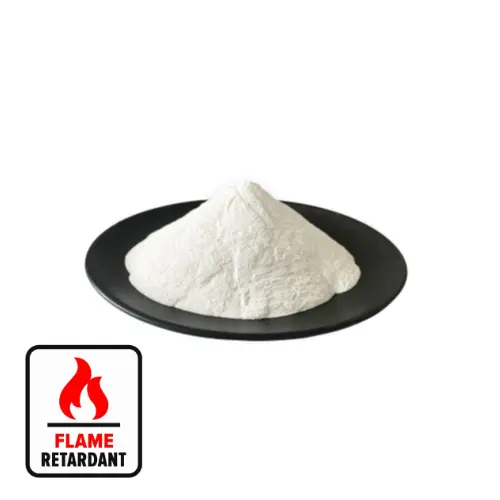Hebei Messi Biology Co., Ltd. stated that plastic is a commonly used material in industrial production and daily life. Plastics are easy to burn and produce a large amount of toxic and harmful substances and smoke when burning. Effectively improving the flame retardancy of plastics is a problem that needs to be solved in practical applications. Magnesium hydroxide (MH) is an environmentally friendly green inorganic flame retardant. It has good flame retardant, smoke suppression and filling effects. It has a high decomposition temperature and does not produce toxic and harmful pollutants when it decomposes. At the same time, MH can be combined with other Flame retardants are used synergistically to achieve higher flame retardant effects.
01Application of magnesium hydroxide flame retardant in PP
PP has low toxicity, low cost, good electrical insulation, good processability and chemical corrosion resistance, and meets the application requirements in automobiles, construction and other fields. However, PP is easy to burn and burns quickly. It produces molten droplets during the combustion process and releases a large amount of toxic smoke. Therefore, it is important to improve the thermal resistance of PP. Activated carbon modified MH flame retardant was prepared using magnesium sulfate, ammonia and activated carbon as raw materials, and applied to PP polymer. The results show that when the modified MH flame retardant is applied to PP, the limiting oxygen index (LOI) of PP is increased from 19.6% to 28.9%, significantly improving its flame retardant performance.
02Application of magnesium hydroxide flame retardant in polystyrene (PS)
PS has the characteristics of low price, easy processing, corrosion resistance, strong impact resistance, and good durability. It is widely used in construction, decoration, electrical, transportation and other industries. PS has a low LOI value, is easy to burn, and can continue to burn after leaving the fire source. During the combustion process, it releases a large amount of heat, toxic smoke, and produces severe droplets, which limits its wide application. Researchers added MH to PS to study the changes in its flame retardant effect. The results show that with the increase in the amount of MH added, the CO2 generated during the thermal degradation of PS continues to decrease, the amount of residual carbon increases sharply, and the content of volatile and semivolatile matter increases, indicating that the addition of MH changes the flame retardancy of PS and improves the flame retardancy of PS. It increases its combustion temperature and changes its combustion mechanism.
03Application of magnesium hydroxide flame retardant in PVC
PVC is also a common thermoplastic general-purpose plastic. It is widely used in fields such as films, pipes, wall panels and electrical materials (especially cable insulation sheaths). It can be divided into hard PVC and soft PVC. Rigid PVC adds less plasticizer, and its flame retardant properties are better than soft PVC. However, PVC contains chlorine, which produces hydrogen chloride gas when burned and decomposed, as well as a large amount of toxic and harmful smoke. Therefore, while improving the flame retardancy of PVC, you also need to pay attention to the large amount of smoke generated when PVC is burned.
MH flame retardant can improve the flame retardant performance of PVC while reducing the emission of toxic and harmful gases, and can be used in PVC composite materials. Different modifiers were used to modify the surface of MH, and the effects of modified MH on the mechanical properties and flame retardancy of PVC were studied. The results show that using zinc stearate as the modifier has the best modification effect, with an oil absorption value of 33.39%. The obtained MH particles are dispersed evenly, the agglomeration phenomenon is significantly improved, and the flame retardant ability of PVC is significantly improved. However, for The tensile strength of PVC plays a role.
04Application of magnesium hydroxide flame retardant in PE
PE has excellent processability, electrical insulation, mechanical properties and high and low temperature resistance. It is widely used in construction, electrical, medical and other industries. However, its LOI value is only about 17.4% and it is easy to burn, which limits its application scope. Improving the flame retardancy of PE is also a hot topic of research. Commonly used flame retardants for PE include halogen, phosphorus and nitrogen, aluminum/magnesium inorganic flame retardants, etc., but MH is favored because of its low cost and environmental friendliness.
Three types of MH with different particle sizes were used as flame retardants and mixed with PE to make composite materials, and their mechanical properties, electrical properties, thermal stability and flame retardant properties were studied. The results show that MH can significantly improve the flame retardancy and thermal stability of PE. When the MH particle size is 3.1 μm, the composite material has the best overall performance, with a tensile strength of 16.1 MPa, elongation at break of 400%, and LOI The value is 22.3%, the peak heat release rate (PHRR) is 270 kW/m2, and the volume resistivity is 5.2×1013Ω·m.
05Challenges and prospects of magnesium hydroxide flame retardants
Hebei Messi Biology Co., Ltd. stated that although magnesium hydroxide is a green, environmentally friendly, flame-retardant material with excellent flame retardant effect and low cost, it can be widely used in the plastics industry. However, because MH is an additive flame retardant, a large amount of it is required. Addition can achieve higher flame retardant requirements; and MH is highly polar and hydrophilic, difficult to disperse in polymers, and prone to agglomeration, which will lead to poor compatibility with plastics. The strength of composite plastics decreases, and the processability and fluidity become worse, which limits their large-scale application in the plastics industry.
In the future, we can improve the flame retardancy of MH and improve its compatibility with plastics by strengthening the ultra-fine refinement of MH, developing new surface modifiers, compounding with other flame retardants, and conducting research on microencapsulation technology. Reduce its impact on the mechanical properties of plastics, thereby expanding the application of MH in the field of plastic flame retardancy.

